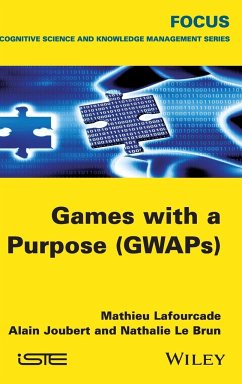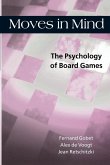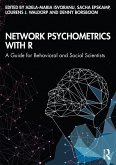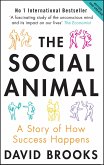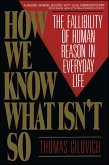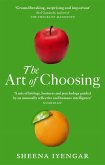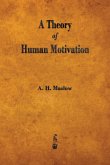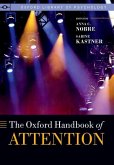- Gebundenes Buch
- Merkliste
- Auf die Merkliste
- Bewerten Bewerten
- Teilen
- Produkt teilen
- Produkterinnerung
- Produkterinnerung
Human brains can be seen as knowledge processors in a distributed system. Each of them can achieve, conscious or not, a small part of a treatment too important to be done by one. These are also "hunter / gatherers" of knowledge.
Andere Kunden interessierten sich auch für
![Moves in Mind Moves in Mind]() Fernand GobetMoves in Mind81,99 €
Fernand GobetMoves in Mind81,99 €![Network Psychometrics with R Network Psychometrics with R]() Network Psychometrics with R87,99 €
Network Psychometrics with R87,99 €![The Social Animal The Social Animal]() David BrooksThe Social Animal12,99 €
David BrooksThe Social Animal12,99 €![How We Know What Isn't So How We Know What Isn't So]() Thomas GilovichHow We Know What Isn't So22,99 €
Thomas GilovichHow We Know What Isn't So22,99 €![The Art Of Choosing The Art Of Choosing]() Sheena IyengarThe Art Of Choosing18,99 €
Sheena IyengarThe Art Of Choosing18,99 €![A Theory of Human Motivation A Theory of Human Motivation]() Abraham H MaslowA Theory of Human Motivation9,49 €
Abraham H MaslowA Theory of Human Motivation9,49 €![The Oxford Handbook of Attention The Oxford Handbook of Attention]() The Oxford Handbook of Attention80,99 €
The Oxford Handbook of Attention80,99 €-
-
-
Human brains can be seen as knowledge processors in a distributed system. Each of them can achieve, conscious or not, a small part of a treatment too important to be done by one. These are also "hunter / gatherers" of knowledge.
Hinweis: Dieser Artikel kann nur an eine deutsche Lieferadresse ausgeliefert werden.
Hinweis: Dieser Artikel kann nur an eine deutsche Lieferadresse ausgeliefert werden.
Produktdetails
- Produktdetails
- Verlag: ISTE Ltd and John Wiley & Sons Inc
- Seitenzahl: 160
- Erscheinungstermin: 10. August 2015
- Englisch
- Abmessung: 240mm x 161mm x 13mm
- Gewicht: 404g
- ISBN-13: 9781848218031
- ISBN-10: 1848218036
- Artikelnr.: 42584023
- Herstellerkennzeichnung
- Libri GmbH
- Europaallee 1
- 36244 Bad Hersfeld
- gpsr@libri.de
- Verlag: ISTE Ltd and John Wiley & Sons Inc
- Seitenzahl: 160
- Erscheinungstermin: 10. August 2015
- Englisch
- Abmessung: 240mm x 161mm x 13mm
- Gewicht: 404g
- ISBN-13: 9781848218031
- ISBN-10: 1848218036
- Artikelnr.: 42584023
- Herstellerkennzeichnung
- Libri GmbH
- Europaallee 1
- 36244 Bad Hersfeld
- gpsr@libri.de
Mathieu LAFOURCADE, LIRMM, Université Montpellier 2, France. Alain JOUBERT, LIRMM, Université Montpellier 2, France. Nathalie LE BRUN, Imagin@T, Fraance.
LIST OF FIGURES ix
INTRODUCTION xiii
CHAPTER 1. BIOLOGICAL GAMES 1
1.1. Foldit 2
1.2. EteRNA 5
1.3. Nanocrafter 8
1.4. Phylo 11
1.5. Fraxinus 15
1.6. Eyewire 18
1.7. Citizen sort 22
1.7.1. Happy match 22
1.7.2. Forgotten Island 24
1.8. The Nightjar project 25
1.8.1. Nightjar game/Nest game 26
1.8.2. Egglab game 28
1.9. References 29
CHAPTER 2. GAMES WITH A MEDICAL PURPOSE 31
2.1. Nanodoc 31
2.2. Dizeez 34
2.3. The Cure 35
2.4. Malaria Training Game 37
2.5. Malaria Spot Game 39
2.6. Worm Watch Lab 42
2.7. Play to Cure: Genes in Space 44
2.8. References 45
CHAPTER 3. GWAPS FOR NATURAL LANGUAGE PROCESSING 47
3.1. Why lexical resources? 47
3.2. GWAPs for natural language processing 48
3.2.1. The problem of lexical resource acquisition 49
3.2.2. Lexical resources currently available 50
3.2.3. Benefits of GWAPs in NLP 53
3.3. PhraseDetectives 54
3.4. PlayCoref 57
3.5. Verbosity 59
3.6. JeuxDeMots 61
3.7. Zombilingo 62
3.8. Infection 64
3.9. Wordrobe 66
3.10. Other GWAPs dedicated to NLP 68
3.10.1. Open Mind Word Expert 68
3.10.2. 1001 Paraphrases 69
3.10.3. Categorilla/Categodzilla 69
3.10.4. FreeAssociation 70
3.10.5. Entity Discovery 70
3.10.6. PhraTris 70
CHAPTER 4. UNCLASSIFIABLE GWAPS 73
4.1. Beat the Bots 73
4.2. Apetopia 75
4.3. Quantum Moves 76
4.4. Duolingo 77
4.5. The ARTigo portal 80
4.5.1. ARTigo and ARTigo Taboo 81
4.5.2. Combino 83
4.5.3. Karido 83
4.6. Be A Martian 85
4.7. Akinator, the genie of the Web 86
4.8. References 89
CHAPTER 5. THE JEUXDEMOTS PROJECT - GWAPS AND WORDS 91
5.1. Building a lexical network 91
5.2. JEUXDEMOTS: an association game 93
5.3. PTICLIC: an allocation game 96
5.4. TOTAKI: a guessing game 98
5.5. Voting games 99
5.5.1. ASKIT 100
5.5.2. LIKEIT 102
5.5.3. SEXIT 104
5.6. Multi-selection games 105
5.7. From games to contributory systems 109
5.8. Data collected and properties of the games presented 112
5.8.1. Instructions/difficult relations 114
5.8.2. Forcing, players typology and error rate 115
CONCLUSION 119
BIBLIOGRAPHY 127
INDEX 135
INTRODUCTION xiii
CHAPTER 1. BIOLOGICAL GAMES 1
1.1. Foldit 2
1.2. EteRNA 5
1.3. Nanocrafter 8
1.4. Phylo 11
1.5. Fraxinus 15
1.6. Eyewire 18
1.7. Citizen sort 22
1.7.1. Happy match 22
1.7.2. Forgotten Island 24
1.8. The Nightjar project 25
1.8.1. Nightjar game/Nest game 26
1.8.2. Egglab game 28
1.9. References 29
CHAPTER 2. GAMES WITH A MEDICAL PURPOSE 31
2.1. Nanodoc 31
2.2. Dizeez 34
2.3. The Cure 35
2.4. Malaria Training Game 37
2.5. Malaria Spot Game 39
2.6. Worm Watch Lab 42
2.7. Play to Cure: Genes in Space 44
2.8. References 45
CHAPTER 3. GWAPS FOR NATURAL LANGUAGE PROCESSING 47
3.1. Why lexical resources? 47
3.2. GWAPs for natural language processing 48
3.2.1. The problem of lexical resource acquisition 49
3.2.2. Lexical resources currently available 50
3.2.3. Benefits of GWAPs in NLP 53
3.3. PhraseDetectives 54
3.4. PlayCoref 57
3.5. Verbosity 59
3.6. JeuxDeMots 61
3.7. Zombilingo 62
3.8. Infection 64
3.9. Wordrobe 66
3.10. Other GWAPs dedicated to NLP 68
3.10.1. Open Mind Word Expert 68
3.10.2. 1001 Paraphrases 69
3.10.3. Categorilla/Categodzilla 69
3.10.4. FreeAssociation 70
3.10.5. Entity Discovery 70
3.10.6. PhraTris 70
CHAPTER 4. UNCLASSIFIABLE GWAPS 73
4.1. Beat the Bots 73
4.2. Apetopia 75
4.3. Quantum Moves 76
4.4. Duolingo 77
4.5. The ARTigo portal 80
4.5.1. ARTigo and ARTigo Taboo 81
4.5.2. Combino 83
4.5.3. Karido 83
4.6. Be A Martian 85
4.7. Akinator, the genie of the Web 86
4.8. References 89
CHAPTER 5. THE JEUXDEMOTS PROJECT - GWAPS AND WORDS 91
5.1. Building a lexical network 91
5.2. JEUXDEMOTS: an association game 93
5.3. PTICLIC: an allocation game 96
5.4. TOTAKI: a guessing game 98
5.5. Voting games 99
5.5.1. ASKIT 100
5.5.2. LIKEIT 102
5.5.3. SEXIT 104
5.6. Multi-selection games 105
5.7. From games to contributory systems 109
5.8. Data collected and properties of the games presented 112
5.8.1. Instructions/difficult relations 114
5.8.2. Forcing, players typology and error rate 115
CONCLUSION 119
BIBLIOGRAPHY 127
INDEX 135
LIST OF FIGURES ix
INTRODUCTION xiii
CHAPTER 1. BIOLOGICAL GAMES 1
1.1. Foldit 2
1.2. EteRNA 5
1.3. Nanocrafter 8
1.4. Phylo 11
1.5. Fraxinus 15
1.6. Eyewire 18
1.7. Citizen sort 22
1.7.1. Happy match 22
1.7.2. Forgotten Island 24
1.8. The Nightjar project 25
1.8.1. Nightjar game/Nest game 26
1.8.2. Egglab game 28
1.9. References 29
CHAPTER 2. GAMES WITH A MEDICAL PURPOSE 31
2.1. Nanodoc 31
2.2. Dizeez 34
2.3. The Cure 35
2.4. Malaria Training Game 37
2.5. Malaria Spot Game 39
2.6. Worm Watch Lab 42
2.7. Play to Cure: Genes in Space 44
2.8. References 45
CHAPTER 3. GWAPS FOR NATURAL LANGUAGE PROCESSING 47
3.1. Why lexical resources? 47
3.2. GWAPs for natural language processing 48
3.2.1. The problem of lexical resource acquisition 49
3.2.2. Lexical resources currently available 50
3.2.3. Benefits of GWAPs in NLP 53
3.3. PhraseDetectives 54
3.4. PlayCoref 57
3.5. Verbosity 59
3.6. JeuxDeMots 61
3.7. Zombilingo 62
3.8. Infection 64
3.9. Wordrobe 66
3.10. Other GWAPs dedicated to NLP 68
3.10.1. Open Mind Word Expert 68
3.10.2. 1001 Paraphrases 69
3.10.3. Categorilla/Categodzilla 69
3.10.4. FreeAssociation 70
3.10.5. Entity Discovery 70
3.10.6. PhraTris 70
CHAPTER 4. UNCLASSIFIABLE GWAPS 73
4.1. Beat the Bots 73
4.2. Apetopia 75
4.3. Quantum Moves 76
4.4. Duolingo 77
4.5. The ARTigo portal 80
4.5.1. ARTigo and ARTigo Taboo 81
4.5.2. Combino 83
4.5.3. Karido 83
4.6. Be A Martian 85
4.7. Akinator, the genie of the Web 86
4.8. References 89
CHAPTER 5. THE JEUXDEMOTS PROJECT - GWAPS AND WORDS 91
5.1. Building a lexical network 91
5.2. JEUXDEMOTS: an association game 93
5.3. PTICLIC: an allocation game 96
5.4. TOTAKI: a guessing game 98
5.5. Voting games 99
5.5.1. ASKIT 100
5.5.2. LIKEIT 102
5.5.3. SEXIT 104
5.6. Multi-selection games 105
5.7. From games to contributory systems 109
5.8. Data collected and properties of the games presented 112
5.8.1. Instructions/difficult relations 114
5.8.2. Forcing, players typology and error rate 115
CONCLUSION 119
BIBLIOGRAPHY 127
INDEX 135
INTRODUCTION xiii
CHAPTER 1. BIOLOGICAL GAMES 1
1.1. Foldit 2
1.2. EteRNA 5
1.3. Nanocrafter 8
1.4. Phylo 11
1.5. Fraxinus 15
1.6. Eyewire 18
1.7. Citizen sort 22
1.7.1. Happy match 22
1.7.2. Forgotten Island 24
1.8. The Nightjar project 25
1.8.1. Nightjar game/Nest game 26
1.8.2. Egglab game 28
1.9. References 29
CHAPTER 2. GAMES WITH A MEDICAL PURPOSE 31
2.1. Nanodoc 31
2.2. Dizeez 34
2.3. The Cure 35
2.4. Malaria Training Game 37
2.5. Malaria Spot Game 39
2.6. Worm Watch Lab 42
2.7. Play to Cure: Genes in Space 44
2.8. References 45
CHAPTER 3. GWAPS FOR NATURAL LANGUAGE PROCESSING 47
3.1. Why lexical resources? 47
3.2. GWAPs for natural language processing 48
3.2.1. The problem of lexical resource acquisition 49
3.2.2. Lexical resources currently available 50
3.2.3. Benefits of GWAPs in NLP 53
3.3. PhraseDetectives 54
3.4. PlayCoref 57
3.5. Verbosity 59
3.6. JeuxDeMots 61
3.7. Zombilingo 62
3.8. Infection 64
3.9. Wordrobe 66
3.10. Other GWAPs dedicated to NLP 68
3.10.1. Open Mind Word Expert 68
3.10.2. 1001 Paraphrases 69
3.10.3. Categorilla/Categodzilla 69
3.10.4. FreeAssociation 70
3.10.5. Entity Discovery 70
3.10.6. PhraTris 70
CHAPTER 4. UNCLASSIFIABLE GWAPS 73
4.1. Beat the Bots 73
4.2. Apetopia 75
4.3. Quantum Moves 76
4.4. Duolingo 77
4.5. The ARTigo portal 80
4.5.1. ARTigo and ARTigo Taboo 81
4.5.2. Combino 83
4.5.3. Karido 83
4.6. Be A Martian 85
4.7. Akinator, the genie of the Web 86
4.8. References 89
CHAPTER 5. THE JEUXDEMOTS PROJECT - GWAPS AND WORDS 91
5.1. Building a lexical network 91
5.2. JEUXDEMOTS: an association game 93
5.3. PTICLIC: an allocation game 96
5.4. TOTAKI: a guessing game 98
5.5. Voting games 99
5.5.1. ASKIT 100
5.5.2. LIKEIT 102
5.5.3. SEXIT 104
5.6. Multi-selection games 105
5.7. From games to contributory systems 109
5.8. Data collected and properties of the games presented 112
5.8.1. Instructions/difficult relations 114
5.8.2. Forcing, players typology and error rate 115
CONCLUSION 119
BIBLIOGRAPHY 127
INDEX 135

